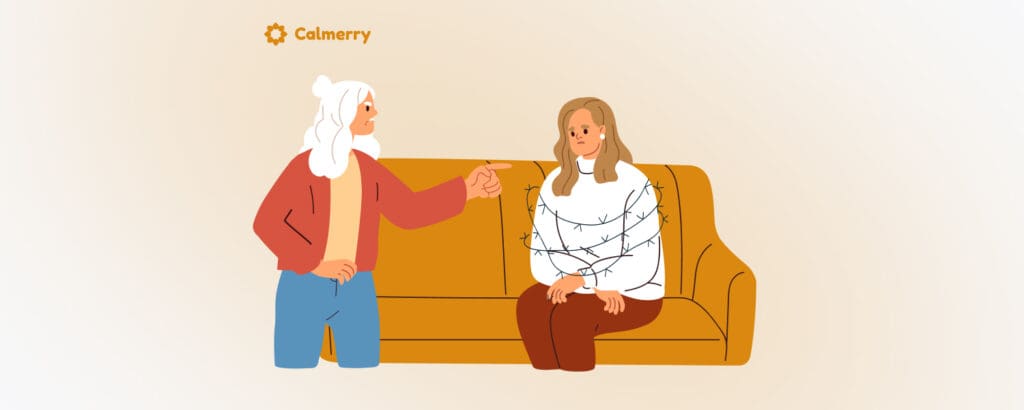Beyond a Childhood Disorder: Separation Anxiety in Adults

In this article
Nearly everyone gets a taste of separation anxiety during their life. As an infant or toddler, it’s a healthy part of our development to feel upset and concerned when we’re separated from our parents or primary caregivers.
Most children start to outgrow this separation anxiety around the age of three. Though for some, it grows in intensity or shows up later in life and can significantly impact a person’s ability to function.
What is separation anxiety?
Separation anxiety is the experience of fear, distress, or worry when a person is separated from important people (or pets) in their life. It often involves an intense concern that something terrible will happen while you’re apart.
With infants, separation anxiety is often a result of the child recognizing that they are dependent on their caretakers, which makes it hard to feel safe when not together.
While it’s common for infants and very young children to experience stages of separation anxiety, separation anxiety disorder is not a typical stage of development and can greatly impact a person’s life.
Separation anxiety disorder
The distinction between a normal separation anxiety and separation anxiety disorder is not always clear. Differences include
- The intensity of the worry
- How much it impacts your life
- Whether your symptoms align with your developmental stage
Sometimes, just the thought of being separated from an attachment figure can cause great distress for a person with separation anxiety disorder.
Separation anxiety disorder symptoms
Anxiety disorders can have both emotional and physical impacts. For example, at the thought of being separated from their parent, a child may become fidgety and upset or actually feel sick to their stomach and refuse to eat.
People with an anxiety disorder may experience
- Feeling nervous or on-edge
- An inability to focus or concentrate
- Irritability
- Restlessness
- A sense of impending doom
- A rapid heartbeat
- Tense or sore muscles
- Headaches
- Stomachaches
- Nausea
- Sore throats
- Sweating
- Exhaustion
As a diagnosable condition, separation anxiety disorder has a set of diagnostic criteria, including an excessive fear or anxiety concerning the separation from certain attachment figures that is accompanied by three or more of the following symptoms
- Recurrent experiences of distress
- Worry about harm coming to the person through illness, injury, disaster, or death
- Worry about a horrible event that will cause separation, including a kidnapping, getting lost, or an accident
- Reluctance or unwillingness to leave home, even to go to work or school, because of the fear of separation
- Reluctance or unwillingness to be alone
- Reluctance or unwillingness to sleep away from home without a major attachment figure being present
- Nightmares about separation
- The experience of physical symptoms as a result of separation (or the anticipation of separation)
To be diagnosed by a medical professional or licensed therapist, these symptoms have to occur for at least four weeks in children and 6 months or more in adults. In addition, they generally need to be severe enough that they cause significant distress and interfere with the person’s ability to live their life.
Signs of separation anxiety
Signs that a person has separation anxiety disorder may include unusual behaviors that come about in an attempt to avoid being separated from another person including
- Following the other person around the house
- Wanting to sleep in the same room with the other person
- Avoiding school, work, or social events where you’ll be separated
- Continually calling to check in when apart
- Experiencing excessive fear that something terrible will happen when you’re apart
- Worrying that you’ll be permanently separated by some unforeseen event
- Having difficulty concentrating when away from the loved one
- Experiencing nightmares about the separation
- Having physical symptoms in reaction to the separation
- Being clingy–including literally clinging to the other person’s arm or leg
- Being strict, jealous, or overbearing in a relationship
- Wanting to know where the person is at all times
- Becoming overly involved in the other person’s life to your own detriment
- Experiencing distress at the mere thought of being apart from the other person
- Getting stuck in unhealthy relationships
Separation anxiety in adults
Previously thought to be an exclusively pediatric diagnosis, separation anxiety disorder is now known to occur in both children and adults.
Recognizing this shift in thinking, the latest revision of the Diagnostic and Statistical Manual of Mental Disorders (DSM) changed the classification of separation anxiety disorder from “Disorders Usually Diagnosed in Infancy, Childhood, and Adolescence” to “Anxiety Disorders.”

An adult can have separation anxiety that persists from childhood, is a recurrence from childhood, or is a completely new issue that begins in adulthood. One thing to note is that a childhood onset of separation anxiety disorder has been linked to the development of additional mental health disorders in young adulthood, while an adult-onset is linked to co-occurring mental disorders.
Separation anxiety disorder has similar symptoms in both children and adults. One difference between adult and childhood disorders is that with children, the anxiety is typically centered around parents or other caretakers, while with adults, the anxiety can be linked to any person (or pet) with whom they have a strong emotional attachment, including children, partners, siblings, or parents.
This can mean that children will avoid going on field trips, participating in after-school activities, or doing anything that keeps them away from their caregivers. With adults, they may avoid important work functions, miss their doctor’s appointments, or experience great distress when the people they’re anxious about going out into the world to live their lives.
What else might it be?
When thinking about diagnosing separation anxiety disorder, there are a few other disorders to consider, which may be the actual cause of the symptoms. This concept is called a differential diagnosis. For social anxiety disorder, the differential diagnosis often includes other anxiety disorders.
Generalized anxiety disorder (GAD)
Generalized anxiety disorder involves excessive fear and worries about any number of events. Amongst other things, a person with GAD may worry about an unforeseen tragic event or illness happening to a loved one. GAD is also linked to emotional and physical symptoms that can greatly impair daily functioning. If the anxiety is not limited to a separation from attachment figures, it’s possible the person has generalized anxiety disorder instead.
Social anxiety disorder
Social anxiety disorder is marked by an avoidance of social situations due to a fear of embarrassment, criticism, scrutiny, or mockery. While a person with social anxiety disorder may not want to go to work or school, a difference between this and separation anxiety disorder is that fear is focused on rejection or humiliation rather than separation.
Panic disorder
Panic disorder is an anxiety disorder that involves recurrent panic attacks and the fear of panic attacks. Panic attacks can happen abruptly and may involve a pounding heart, sweating, difficulty breathing, chest pain, nausea, light-headedness, numbness, fear of dying, and even a detachment from reality. While a person with separation anxiety disorder can experience panic attacks, the main difference is that there isn’t dread with anticipation of another panic attack to come.
Agoraphobia
Agoraphobia is an anxiety disorder that revolves around the fear of being outside of the home alone, in a crowd, in an enclosed (e.g., movie theater) or open (e.g., field) space, or using public transportation. Fear of leaving the house is also a common symptom of social anxiety disorder. In this case, the reason for not wanting to leave is rooted in fear of being separated from the important attachment figure.
A combination of issues
A person may also have multiple disorders at once, including separation anxiety disorder and another anxiety disorder, a mood disorder (e.g., depression or bipolar disorder), attention-deficit/hyperactivity disorder (ADHD), a personality disorder, or another mental health condition.
In addition, some of the symptoms in adults, including being controlling, jealous, or overbearing, can also overlap with signs of an abusive relationship.
Severe separation anxiety
In severe cases, separation anxiety disorder can cause major problems in functioning and combine with other disorders, such as obsessive-compulsive disorder or depression, which may amplify the symptoms.
In addition, there may be a link between adult separation anxiety disorder and suicidal thoughts. If you experience thoughts about suicide in conjunction with your separation anxiety, it’s important to reach out for help and let someone know.
What causes separation anxiety?
While the causes of separation anxiety disorder are yet to be determined, several risk factors have been identified or theorized, including:
- A family history of social anxiety disorder
- Overall life stress
- Being female
- The experience of childhood family adversities (e.g., parental mental illness, domestic violence, abuse, and neglect)
- Traumatic experiences (e.g., natural disasters, combat, the death of a loved one)
- A significant life transition (e.g., going to college, having a baby)
- Having overbearing parents
- Having a perception that your parents rejected you
- Having another mental health disorder (e.g., an anxiety disorder, PTSD, mood disorder)
- Anything that throws your world off balance
- An unfamiliar environment (e.g., moving somewhere new)
Risk factors are one way of understanding a mental health condition and recognizing potential opportunities for early intervention. That said, having any of these risk factors does not necessarily mean that a person is going to develop separation anxiety disorder. And not having any risk factors doesn’t mean they won’t.
How to deal with separation anxiety in adults
For general feelings of separation anxiety that do not meet diagnostic criteria, you may consider trying some techniques to get comfortable with the idea of parting including
- Practicing separations for short periods of time that are planned in advance (e.g., you or the other person does a short errand on your own rather than together)
- Developing a goodbye ritual, such as a hug or certain words that you always say to make it fun (this is commonly used with children who have separation anxiety, but it can be soothing for adults as well)
- Making a plan for something that you’ll do together once you reunite (e.g., when they return from the grocery store, we’ll cook dinner together)
- Noticing when your fears arise and exploring alternative evidence (e.g., every time my partner has gone to the office, they’ve returned at the end of the day just fine)
- Educating yourself on the symptoms of separation anxiety disorder, so you know what to look out for
- Expressing your thoughts and feelings in a non-judgemental way through journaling, talking to your friends, and starting therapy
- Leaving extra time for separations when possible, so they don’t feel rushed
- Participating in activities that develop your sense of self as an individual, including art, writing, learning a language, playing an instrument, learning a new skill, or exploring a hobby that interests you
- Exercising regularly, which can reduce the effects of stress and positively impact your mental health
- Eating healthy foods, including fruit, vegetables, and healthy fats
- Practicing relaxation or grounding techniques, including yoga, mindfulness exercises, or meditation
- Making space in your schedule to get a full night’s sleep
- Praising yourself when you’re able to separate from the person without as much difficulty
If you start to notice that your fears of separating from the people who are important to you are causing you to withdraw from your friends, family members, and colleagues, miss a fair amount of work or school, avoid leaving your house, feel physically ill, or experience anything else that gets in the way of your life, consider getting assessed for social anxiety disorder.
Treatments for adult separation anxiety disorder
More research is needed to determine the best treatment for adult separation anxiety disorder, though current treatments include
- Psychotherapy (e.g., cognitive behavioral therapy)
- Family therapy
- Medications
It can be helpful to connect with an online therapist whether you have a few nagging symptoms of separation anxiety or are dealing with a diagnosed separation anxiety disorder. Your therapist will work with you to uncover your specific issues and develop a treatment plan that aligns with your ultimate goals so you can live your life on your own terms.
online therapy
live video session



